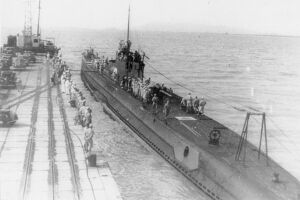Engineering:Type A1 submarine
 I-10 in Penang, 1942
| |
| Class overview | |
|---|---|
| Operators: |
|
| Preceded by: | Type J3 submarine |
| Succeeded by: | Type A2 submarine |
| Built: | 1939–1942 |
| In service: | 1941–1944 |
| Planned: | 5 |
| Completed: | 3 |
| Cancelled: | 2 |
| Lost: | 3 |
| General characteristics | |
| Type: | Cruiser submarine |
| Displacement: | |
| Length: | 113.7 m (373 ft) (o/a) |
| Beam: | 9.5 m (31 ft 2 in) |
| Draft: | 5.3 m (17 ft 5 in) |
| Installed power: |
|
| Propulsion: |
|
| Speed: |
|
| Range: |
|
| Test depth: | 100 m (330 ft) |
| Crew: | 100 |
| Armament: |
|
| Aircraft carried: | 1 × Yokosuka E14Y seaplane |
| Aviation facilities: | 1 × catapult |
The Type A1 submarine (巡潜甲型潜水艦 Junsen kō-gata sensuikan, "Cruiser submarine type A"), also called I-9-class submarine (伊九型潜水艦 I-kyū-gata sensuikan) were a trio of aircraft-carrying cruiser submarines built for the Imperial Japanese Navy (IJN) during the 1930s. All three participated in the Pacific War and were lost.
Design and description
The submarines of the A1 type were versions of the preceding J3 class with superior range, improved aircraft installation. Unlike the earlier boats, they were equipped with extensive communication facilities to allow them to serve as squadron flagships.[1] They displaced 2,966 metric tons (2,919 long tons) surfaced and 4,195 t (4,129 long tons) submerged. The submarines were 113.7 meters (373 ft) long, had a beam of 9.5 meters (31 ft 2 in) and a draft of 5.3 meters (17 ft 5 in). They had a diving depth of 100 meters (330 ft).[1]
For surface running, the boats were powered by two 6,200-brake-horsepower (4,623 kW) diesel engines, each driving one propeller shaft. When submerged each propeller was driven by a 1,200-horsepower (895 kW) electric motor. They could reach 19 knots (35 km/h; 22 mph) on the surface[2] and 8.25 knots (15.28 km/h; 9.49 mph) underwater. On the surface, the A1s had a range of 16,000 nautical miles (30,000 km; 18,000 mi) at 16 knots (30 km/h; 18 mph); submerged, they had a range of 90 nmi (170 km; 100 mi) at 3 knots (5.6 km/h; 3.5 mph).[3]
The boats were armed with six internal bow 53.3 cm (21 in) torpedo tubes and carried a total of 18 torpedoes. They were also armed with a single 40-caliber 140 mm (5.5 in) deck gun and two twin 25 mm (1 in) Type 96 anti-aircraft guns.[3]
Unlike the J3 class, the aircraft hangar was integrated into the conning tower and faces forward; the positions of the deck gun and the catapult were exchanged so the aircraft could use the forward motion of the ship to supplement the speed imparted by the catapult. The hangar could be accessed from inside the pressure hull and the floatplane was stowed with its wings folded.[3]
Boats
- I-9 was sunk by destroyer USS Frazier in the Aleutians on 11 June 1943.
- I-10 was sunk by destroyer USS David W. Taylor and destroyer escort USS Riddle east of Saipan on 4 July 1944.
- I-11 disappeared south of Funafuti after 11 January 1944. The I-11 probably struck a mine laid by USS Terror.
Two more boats were ordered under the 1942 Naval Program, but were later cancelled.[1]
Notes
- ↑ Jump up to: 1.0 1.1 1.2 Bagnasco, p. 188
- ↑ Chesneau, p. 200
- ↑ Jump up to: 3.0 3.1 3.2 Carpenter & Dorr, p. 101
References
- Bagnasco, Erminio (1977). Submarines of World War Two. Annapolis, Maryland: Naval Institute Press. ISBN 0-87021-962-6.
- Boyd, Carl; Yoshida, Akikiko (2002). The Japanese Submarine Force and World War II. Annapolis, Maryland: Naval Institute Press. ISBN 1-55750-015-0.
- Carpenter, Dorr B.; Polmar, Norman (1986). Submarines of the Imperial Japanese Navy 1904–1945. London: Conway Maritime Press. ISBN 0-85177-396-6.
- Chesneau, Roger, ed (1980). Conway's All the World's Fighting Ships 1922–1946. Greenwich, UK: Conway Maritime Press. ISBN 0-85177-146-7.
- Hashimoto, Mochitsura (1954). Sunk: The Story of the Japanese Submarine Fleet 1942 – 1945. Colegrave, E.H.M. (translator). London: Cassell and Company. ASIN B000QSM3L0.
- Stille, Mark (2007). Imperial Japanese Navy Submarines 1941-45. New Vanguard. 135. Botley, Oxford, UK: Osprey Publishing. ISBN 978-1-84603-090-1.
 |

